300 Blackout vs 7.62x39 | What's The Better Choice?
There are a plethora of rifle cartridges available, each with its unique shape, design, and optimized features for different shooting purposes. Therefore, it is essential to select the appropriate and high-quality ammunition for your firearm carefully.
Among the vast array of cartridge brands and products, 300 Blackout vs 7.62×39 has established itself as a noteworthy contender due to its exceptional performance and desirable attributes.
If you have narrowed your options to these two products, you want to take advantage of this informative post.
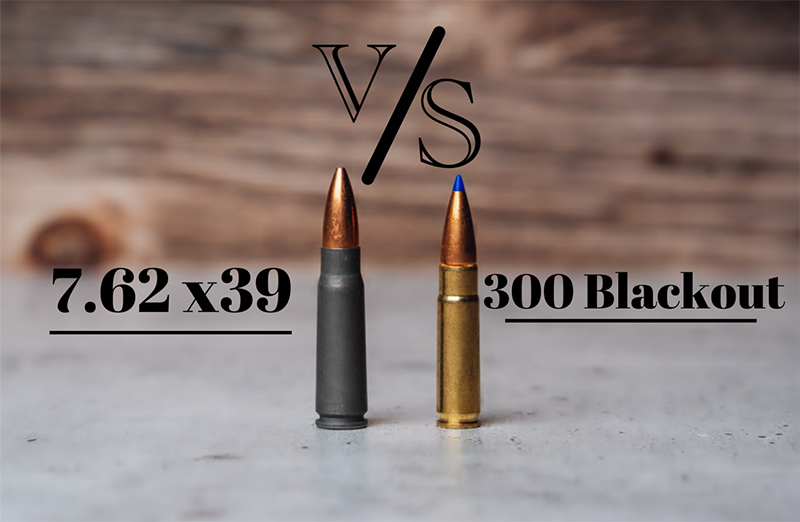
You might be interested to learn more about 300 Blackout vs 5.56 Ammo.
In this article, we will discuss the core differences between 300 Blackout vs 7.62 and provide you with valuable insights that will aid you in selecting the most suitable ammunition for your needs.
Without further ado, let's jump straight into the details!
What is the Difference Between 7.62 x39 and 300 Blackout?
7.62 and 300 Blackout are two popular rifle cartridges with distinct differences in their performance and characteristics.
7.62×39 is a Russian-designed cartridge primarily used in AK-47 rifles. It has a bullet diameter of 7.62mm, a case length of 39mm, and is typically loaded with a 123-grain bullet. The 7.62×39 cartridge has a muzzle velocity of around 2,400 feet per second and is known for its reliability and ability to penetrate barriers.
On the other hand, 300 Blackout, also known as 300 AAC Blackout, is an American-designed cartridge with a bullet diameter of .308 inches, case length of 1.368 inches, and typically loaded with a 110 to 220-grain bullet. The 300 Blackout cartridge has a muzzle velocity of around 1,000 to 2,350 feet per second, depending on the bullet weight, and is known for its versatility and adaptability to a wide range of shooting applications.
One of the biggest differences between the two cartridges is that even though they are both classified as .30 caliber cartridges, they do not use the same diameter bullets.
In summary, while both 7.62×39 and 300 Blackout have their strengths and weaknesses, choosing between them ultimately depends on your specific shooting needs and preferences.
300 Blackout vs 7.62x39: History
The .300 Blackout and the 7.62x39mm cartridges have unique histories contributing to their popularity in the shooting community.
The 300 Blackout, also known as the .300 AAC Blackout or 7.62x35mm, was developed in the early 2010s by Advanced Armament Corporation (AAC) in collaboration with Remington Defense. The goal was to create a versatile cartridge that could be used in an AR-15 platform and offer superior performance in short-barreled rifles and suppressors. The .300 Blackout achieves this by using a heavier bullet and a shorter case, providing increased accuracy, velocity, and stopping power at shorter ranges than the traditional 5.56x45mm NATO cartridge.
On the other hand, the 7.62x39mm cartridge has a much longer history dating back to the Soviet Union in the late 1940s. It was developed for the AK-47 rifle and served as the primary cartridge for the Soviet Union during the Cold War. The 7.62x39mm is known for its reliability, affordability, and effectiveness at short-to-medium ranges, making it a popular choice for hunting and self-defense.
In summary, while the .300 Blackout has a relatively short history, it was designed to meet modern shooting demands, whereas the 7.62x39mm cartridge has a long-standing reputation for its reliability and effectiveness.
300 Blackout vs 7.62x39: Cartridge Size
| Specification | .300 Blackout | 7.62x39 |
| Bullet Diameter | .308 inches (7.82 mm) | .312 inches (7.92 mm) |
| Case Length | 1.368 inches (34.7 mm) | 1.52 inches (39.7 mm) |
| Overall Length | 2.26 inches (57.4 mm) | 2.2 inches (56 mm) |
| Bullet Weight Range | 78 to 240 grains (5.1 to 15.6 g) | 122 to 154 grains (7.9 to 10 g) |
| Effective Range | Up to 460 yards (420 m) | Up to 330 yards (300 m) |
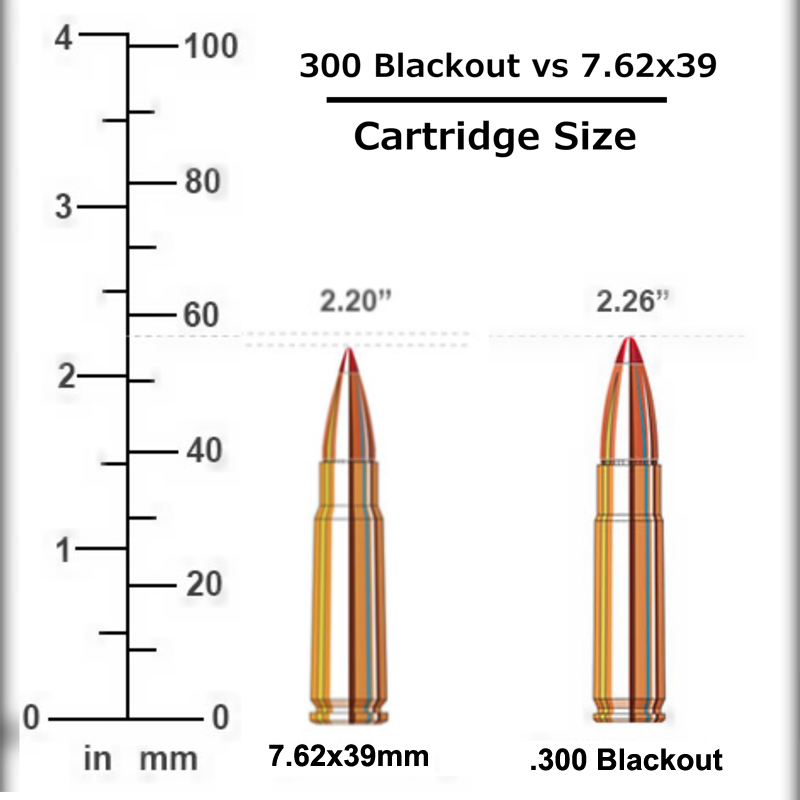
As you can see from the above chart, the .300 Blackout, and 7.62x39 cartridges have some notable differences in terms of bullet diameter, case length, overall length, rifling twist rate, muzzle velocity, bullet weight range, recoil, and effective range. Choosing between these cartridges depends on the shooter's intended use and personal preferences.
300 Blackout vs 7.62x39: Ballistics
Comparing the ballistics of the .300 Blackout and the 7.62x39mm cartridges involves looking at various factors like velocity, energy, and trajectory. Here's a general overview of the ballistics of these two cartridges:
300 Blackout vs 7.62x39 Bullet Weight
- 300 Blackout typically fires bullets in the 110 to 220-grain range, while 7.62x39 usually fires bullets between 122 and 154 grains.
- The heavier bullets used in 300 Blackout have a better ballistic coefficient, which means they can maintain their velocity and energy over longer distances.
300 Blackout vs 7.62x39: Muzzle Velocity
- The muzzle velocity of 300 Blackout ranges from 1,900 to 2,300 feet per second (fps), depending on the bullet weight and load used.
- The muzzle velocity of 7.62x39 ranges from 2,100 to 2,400 fps, depending on the bullet weight and load used.
- Generally, the higher the velocity, the flatter the trajectory and the more energy the bullet carries.
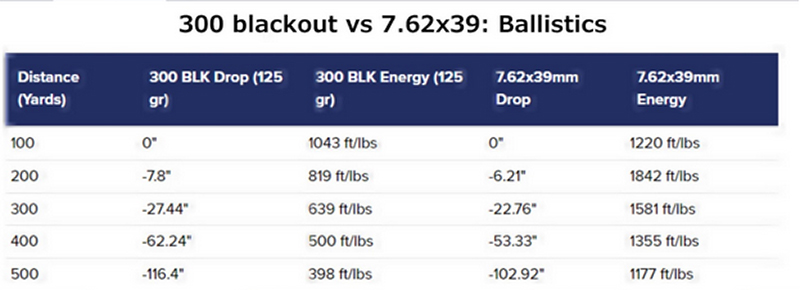
300 Blackout vs 7.62x39: Muzzle Energy
- The muzzle energy of 300 Blackout ranges from 1,100 to 1,400 foot-pounds (ft-lbs), depending on the bullet weight and load used.
- The muzzle energy of 7.62x39 ammo ranges from 1,300 to 1,600 ft-lbs, depending on the bullet weight and load used.
- The higher the energy, the more stopping power the cartridge has.
300 Blackout vs 7.62x39: Trajectory
Trajectory is how we quantify a bullet’s flight path as it travels downrange measured in inches of bullet drop.
If there will be too much drop that will affect your shooting accuracy & there may be chances to miss the target. So, the flatter the trajectory, the better shooting.
When it comes to trajectory difference between 300 blackout vs 7.62x39, None of the bullets had an extremely flat trajectory. However, the 7.62x39 will have a better trajectory from both of these bullets.
At 400 yards, the 123 grain 7.62x39 will have experienced about -44” of bullet drop while the 125 grain 300 BLK will have dropped approximately -68”.
300 Blackout vs 7.62x39: Accuracy
- Both cartridges can be accurate, but 300 Blackout generally has a slight edge in accuracy due to the heavier bullets and slower velocities.
- The accuracy of both cartridges can be affected by the quality of the rifle and ammunition used.
300 Blackout vs 7.62x39: Recoil
300 Blackout: generally has moderate recoil, depending on the weight of the bullet and the rifle's configuration. 7.62x39: generally has a bit more recoil than the 300 Blackout due to the larger bullet.
300 Blackout can be managed with proper technique and equipment, such as a recoil pad or muzzle brake. 7.62x39 may require more attention to recoil management due to the larger recoil impulse. C. Potential for muzzle rise 300 Blackout: generally has less muzzle rise due to its lower recoil impulse. 7.62x39 may have more muzzle rise than the 300 Blackout due to its larger recoil impulse.
Overall, both cartridges are manageable in terms of recoil. Still, the 300 Blackout may be easier to manage due to its lower recoil impulse and potential for less muzzle rise. However, proper technique and equipment can help manage recoil for both cartridges.
300 Blackout vs 7.62×39: Reloading
When it comes to reloading, both 300 Blackout and 7.62×39 cartridges have unique characteristics that need to be considered.
Due to its design, reloading 300 Blackout can be a bit more complicated than other cartridges. The cartridge has a smaller neck, making it difficult to seat the bullet and crimp it securely. Additionally, the brass case for 300 Blackout needs to be formed from .223 brass, adding an extra step to the reloading process.
On the other hand, reloading 7.62×39 is relatively straightforward. The cartridge has a larger neck, making it easier to seat the bullet, and the brass case is readily available and easy to find.
Another factor to consider is the availability of reloading components. 300 Blackout is a relatively new cartridge, and finding reloading components such as brass, bullets, and powder can be challenging. In contrast, 7.62×39 is a widely used cartridge, and reloading components are more readily available.
In summary, if you're an experienced reloader who enjoys a challenge and has access to the necessary components, reloading 300 Blackout can be a rewarding experience. However, if you're looking for a more straightforward reloading process with readily available components, 7.62×39 may be the better choice.
300 Blackout vs 7.62×39: Stopping Power
When comparing 300 Blackout vs 7.62×39, one of the crucial factors to consider is stopping power. Stopping power refers to the cartridge's ability to effectively halt a target's forward motion.
Both cartridges are well-known for their stopping power but achieve it differently.
300 Blackout has a larger bullet diameter, which results in a more significant impact on the target. Additionally, the bullet's design and weight can be optimized for specific purposes, such as subsonic rounds for stealthy applications.
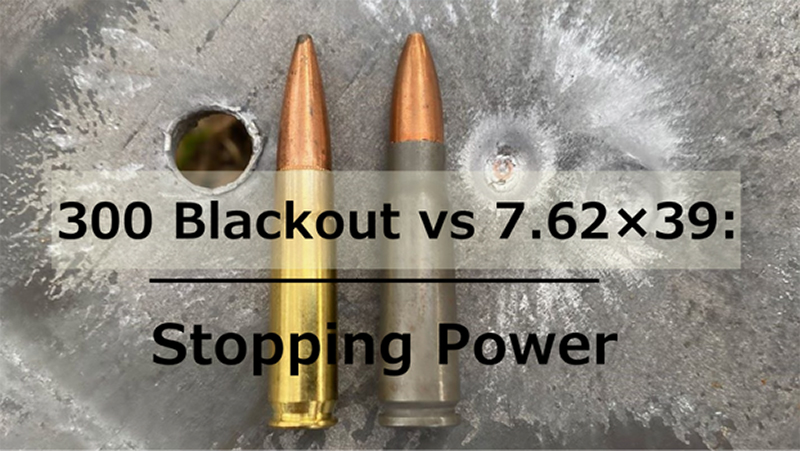
On the other hand, 7.62×39 cartridges are renowned for their penetration ability due to their high velocity and smaller bullet diameter. This characteristic makes them ideal for taking down games at longer ranges.
Ultimately, when it comes to stopping power, it boils down to personal preference and the intended use of the ammunition.
300 Blackout vs 7.62×39: Magazine
One advantage of the 300 Blackout cartridge is that it can be used with standard AR-15 magazines. This makes it easy for those already owning an AR-15 platform rifle to switch to the 300 Blackout without purchasing new magazines. However, the 7.62x39mm cartridge requires a specialized magazine due to the cartridge's unique shape and dimensions.
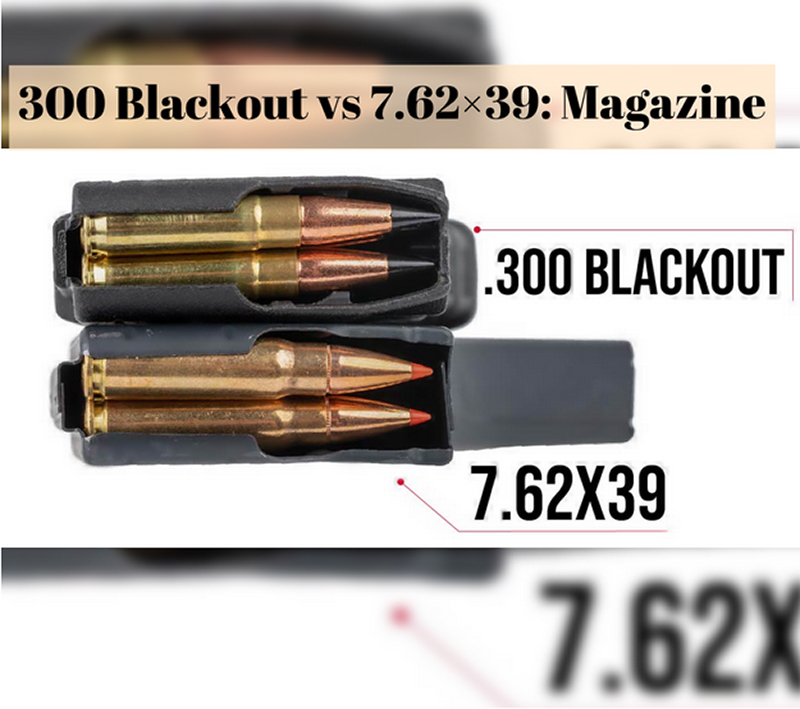
Magazines for the 7.62x39mm cartridge can be more difficult to find and are generally more expensive than standard AR-15 magazines. Additionally, some lower-quality magazines may not reliably feed the 7.62x39mm cartridge, which can result in malfunctions or stoppages.
The typical magazine capacity for the 300 Blackout is 30 rounds, which is the same as standard AR-15 magazines. However, depending on the magazine design, the 7.62x39mm cartridge typically has a lower magazine capacity of 10-30 rounds. This can be a disadvantage when a higher magazine capacity is desired.
Conclusion
In conclusion, both the 300 Blackout and 7.62x39mm cartridges have their strengths and weaknesses. The 300 Blackout is a versatile cartridge with high energy and accuracy, making it well-suited for hunting and self-defense. It can also use subsonic ammunition for stealth operations. However, shooting can be more expensive and has limited magazine capacity. The 7.62x39mm cartridge is reliable, affordable, and has a reputation for stopping power. It is widely available and has a variety of firearms and accessories chambered for it. However, it can have a more pronounced drop at longer ranges and requires specialized magazines. Ultimately, the best cartridge for an individual will depend on their specific needs and preferences.

